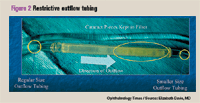Article
Integrated phaco platform facilitates safe cataract surgery with decreased energy
The internal controls and responsiveness to changes in vacuum with a new integrated phacoemulsification platform (Stellaris Vision Enhancement System, Bausch & Lomb) have made high-vacuum coaxial microincision surgery a safe and efficient procedure. The system also helps decrease the amount of excess energy added to the eye beyond what is needed to remove a cataract.

Key Points

The system also helps decrease the amount of excess energy added to the eye beyond what is needed to remove a cataract, she said.
"There are benefits to the use of smaller incisions," Dr. Davis said, "in that the procedure produces less astigmatism, the intraoperative safety is enhanced, chamber stability is increased with the closed intraocular environment, better pupillary dilation, viscoelastics are retained better and provide more safety to the endothelium and other ocular structures, and the risk of infection is decreased." She is a partner, Minnesota Eye Consultants, and adjunct clinical assistant professor, University of Minnesota, Minneapolis.

Dr. Davis said she prefers to perform a supracapsular iris plane technique with mechanical chopping in the iris plane, which minimizes the amount of phaco power required. She performs a 1.8-mm coaxial surgery with linear power ranging from 0% to 4% and linear vacuum of up to 600 mm Hg. This system allows the use of high vacuum for aspiration instead of phaco power. She also uses flow-restrictive tubing (StableChamber, Bausch & Lomb), which prevents post-occlusion surge, to stabilize the chamber.
Dr. Davis and colleagues evaluated 50 patients (mean age, 67.4 years; range, 34 to 85 years) who underwent the modified supracapsular, high-vacuum technique with the system's vacuum module performed through a 1.8-mm incision.
In this study population, two eyes had undergone a previous LASIK procedure, two eyes had age-related macular degeneration, two eyes were in a patient with hydrocephalus, one eye had Fuchs' dystrophy, and one eye had had a previous retinal detachment-all of which limited best-corrected visual acuity (BCVA) achieved.
The mean phaco time was 0.22 seconds (range, 0 to 4 seconds), the mean phaco power was 0.3% (range, 0% to 9%), and the mean surgical time from incision to wound sealing was 6.6 minutes (3 to 11 minutes). In 94% of patients, she reported, the mean phaco power was 0%, and the surgical time in 82% ranged from 4 to 8 minutes with high vacuum.
Dr. Davis reported using power up to 9% in three eyes, but that power was used for less than 4 seconds.
Newsletter
Don’t miss out—get Ophthalmology Times updates on the latest clinical advancements and expert interviews, straight to your inbox.




